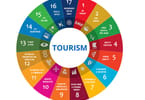According to the United Nations World Tourism Organization (UNWTO), the Middle East region saw tourism decline by 18 percent between January and April compared with the same period last year. This drop proves to be worst than the global tourism decline measured by the UNWTO at eight percent.
While global tourism numbers have continued to decline, the MENA (Middle East North Africa) region is faring relatively well, being one of the few regions to experience a continued increase in arrivals over the first quarter of 09, according to the Naseba Investment series. Concerted government policies to promote the local tourism industries have been a key factor in the area.
Preliminary figures from the UNWTO’s World Tourism Barometer show however that the United Arab Emirates (the country of the world famous destination of Dubai) has seen a growth in tourist numbers during the first four months of this year. Despite the global slump, the Emirates’ tourism industry performed better than the rest in Arabia showing a three percent growth from last year. In Dubai, government involvement entailed a major new promotional campaign, reduced fares on Emirates Airlines and governmental pressure to reduce hotel rates to improve international competitiveness on the market.
Governments in the MENA region have also started to recognize the need to improve the level of corporate governance and real estate market transparency, added Naseba. Banks scrutinize projects more closely, requiring a much higher level of due diligence and a corresponding requirement for more accurate and reliable market date to be made available to potential investors.
On March 24, a Jones Lang LaSalle report said a number of recovery signposts have emerged, while none of the necessary conditions for recovery have been met. During the first quarter of 2009, some progress has been made with ‘green shoots of recovery’ being recognized in respect of over half of the 17 requirements for recovery Jones Lang LaSalle has identified.
Further to a forecast the UNWTO made on its 2020 Tourism Vision for the Middle East, the Middle East is likely to see its oil revenues decrease during the next 20 to 30 years, and with no other mineral resources to sell, countries are turning to tourism, capitalizing on their other natural assets – historic and Islamic traditions.
The organization expects the numbers to go up to 69 N by 2020, representing an annual growth rate of 7.1 percent for the period from 1995-2020, and three percentage points above the global rate. However, due to the global recession, the MENA region now lags behind the world’s tourism performance by 10 points.
John Kester, chief of market trends at the UNWTO, told the National, “The Middle East is cooling down from a number of years of very fast growth.”
The Tourism Barometer said destinations worldwide recorded a total of 247 million international tourist arrivals in the first four months of this year, down from 269 million last year. With the correction in the report, the UNWTO will revise the barometer to the new forecast for international tourism to decrease by between -6 percent and -4 four percent in 2009, as the pace of decline is expected to ease during the remainder of 2009.
In the MENA region, the timing of recovery will vary per country, as different markets are at different stages in their cycle. Most are expected to enter a transition stage over the next 6-9 months are negative sentiment diminishes, said Naseba. “We expect 2010 to remain a year of relative stability before the markets experience a marked upturn as they move into the recovery stage during 2011,” reported Jones Lang LaSalle in its Investor Sentiment Survey, according to Naseba.
WHAT TO TAKE AWAY FROM THIS ARTICLE:
- With the correction in the report, the UNWTO will revise the barometer to the new forecast for international tourism to decrease by between -6 percent and -4 four percent in 2009, as the pace of decline is expected to ease during the remainder of 2009.
- Further to a forecast the UNWTO made on its 2020 Tourism Vision for the Middle East, the Middle East is likely to see its oil revenues decrease during the next 20 to 30 years, and with no other mineral resources to sell, countries are turning to tourism, capitalizing on their other natural assets – historic and Islamic traditions.
- While global tourism numbers have continued to decline, the MENA (Middle East North Africa) region is faring relatively well, being one of the few regions to experience a continued increase in arrivals over the first quarter of 09, according to the Naseba Investment series.






















